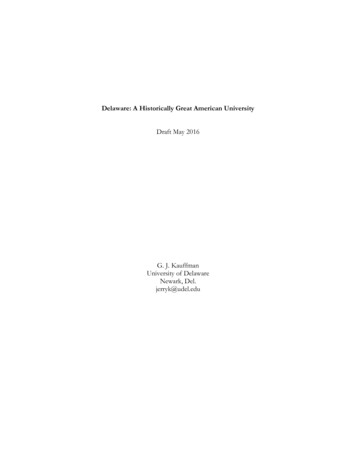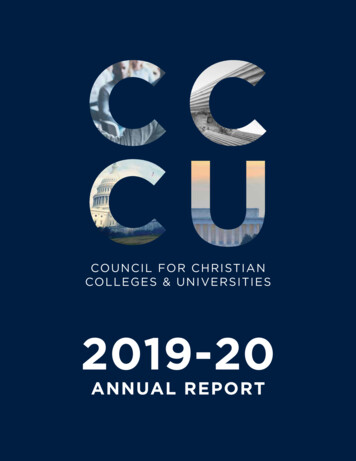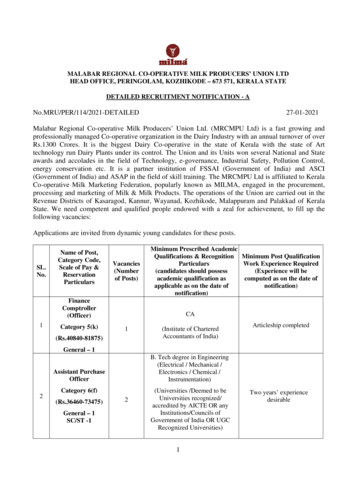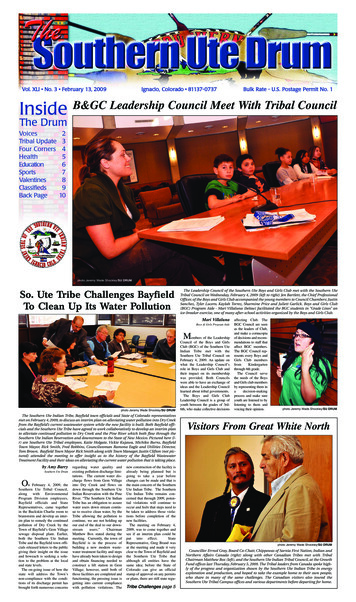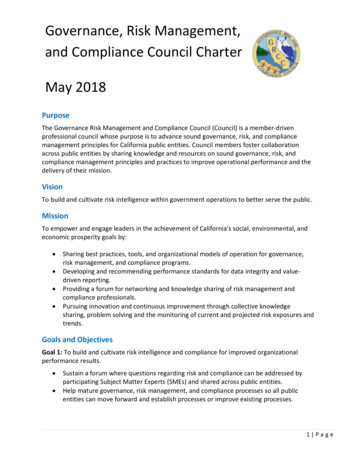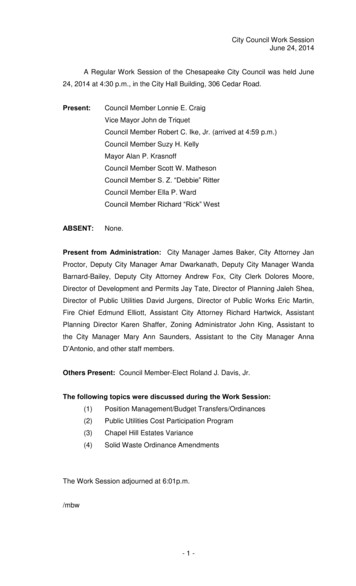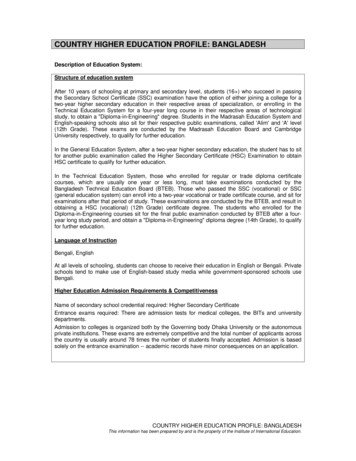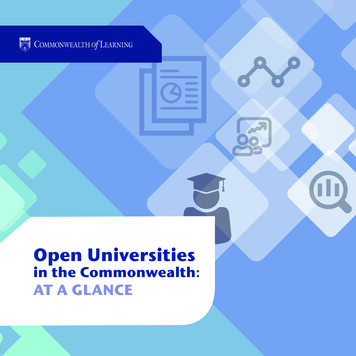
Transcription
Open Universitiesin the Commonwealth:AT A GLANCE
Open Universitiesin the Commonwealth:AT A GLANCE
The Commonwealth of Learning (COL) is an intergovernmental organisation created byCommonwealth Heads of Government to promote the development and sharing of openlearning and distance education knowledge, resources and technologies. 2017 by Commonwealth of Learning.Open Universities in the Commonwealth: At a Glance is made available under a CreativeCommons Attribution-ShareAlike 4.0 Licence (international): http://creativecommons.org/licences/by-sa/4.0.For the avoidance of doubt, by applying this licence the Commonwealth of Learning doesnot waive any privileges or immunities from claims that they may be entitled to assert,nor does the Commonwealth of Learning submit itself to the jurisdiction, courts, legalprocesses or laws of any jurisdiction.This report was prepared by Dr. Sanjaya Mishra, Education Specialist, eLearning,Commonwealth of Learning, Canada.ISBN: 978-1-894975-89-6Acknowledgements:We are grateful to the heads of all the open universities in the Commonwealth forproviding data for preparation of the report. Thanks to Ms. Annegret Wittfoth (Intern) atCOL for data coding and preliminary analysis.Cite as: COL. (2017). Open universities in the Commonwealth: At a glance. Burnaby: COL.Published by:COMMONWEALTH OF LEARNING4710 Kingsway, Suite 2500Burnaby, British ColumbiaCanada V5H 4M2Telephone: 1 604 775 8200Fax: 1 604 775 8210Web: www.col.orgEmail: info@col.org
ContentsAbbreviations.2Foreword.3At a Glance.4Overview.7Teaching and Learning Systems.8Educational Programmes Offered.9Learner Support Services. 11Student Enrolment. 11Staffing.13Finance.15Governance.19Research .19International Reach.20Achievements.20Priorities.21Key Trends and Conclusions.22Notes.24Annex: Profiles of the Open Universitiesin the Commonwealth.25OPEN UNIVERSITIES IN THE COMMONWEALTH: AT A GL ANCE1
AbbreviationsAIOUAllama Iqbal Open UniversityAUAthabasca UniversityBAOUDr. Babasaheb Ambedkar Open UniversityBOUBangladesh Open UniversityBRAOUDr. B. R. Ambedkar Open UniversityICTInformation and communication technologyIGNOUIndira Gandhi National Open UniversityKKSHOUKrishna Kanta Handiqui State Open UniversityKSOUKarnataka State Open UniversityLMSLearning management systemMOOCMassive open online courseMPBOUMadhya Pradesh Bhoj (Open) UniversityNOUNalanda Open UniversityNOUNNational Open University of NigeriaNSOUNetaji Subhas Open UniversityODLOpen and distance learningOEROpen educational resourcesOSOUOdisha State Open UniversityOUOpen universityOUCOpen University of CyprusOUMOpen University MalaysiaOUMaOpen University of MauritiusOUSLOpen University of Sri LankaOUTOpen University of TanzaniaPSSOUPandit Sundarlal Sharma (Open) UniversitySLMSelf-learning materialTNOUTamil Nadu Open UniversityUKOUThe Open UniversityUNISAUniversity of South AfricaUOUUttarakhand Open UniversityUPRTOUUttar Pradesh Rajarshi Tandon Open UniversityVMOUVardhaman Mahaveer Open UniversityWOUWawasan Open UniversityYCMOUYashwantrao Chavan Maharashtra Open UniversityOPEN UNIVERSITIES IN THE COMMONWEALTH: AT A GL ANCE2
ForewordWhen the Commonwealth of Learning(COL) was established in 1987, therewere 11 open universities in theCommonwealth: six in Asia, three inCanada, and one each in South Africaand the United Kingdom. Today, thenumber of dedicated single-mode openuniversities in the Commonwealth has tripled. Several yearsago, the International Centre for Distance Learning (ICDL),at The Open University (UK), collected data about thenumber of courses and programmes offered by distanceteaching institutions in the world. Today, such a source isnot available, and it is a challenge to obtain data on thenumber of students, courses and programmes offered ata distance. Due to the emergence of online providers andcampus institutions offering online programmes, open anddistance learning (ODL) is no longer the preserve of openuniversities. The field is much wider than it was 30 yearsago, and technology is increasingly contributing to thedeath of “distance.” It has become an arduous task to trackdata about distance education. COL has focused on theopen universities in the Commonwealth rather than on allproviders of ODL.This data source on open universities in theCommonwealth will be a valuable resource for both policymakers and practitioners. All the information provided inthis report is based on the responses received. Our efforthas been to present the data to help readers compare andcontrast similar institutions and draw their ownconclusions for appropriate action.The report presents some interesting information — thereare over 4.4 million learners enrolled in the 27 openuniversities in the Commonwealth, who have a choice ofover 2,497 programmes and 18,342 courses in almost alldisciplines, ranging from humanities to engineering. Indiahas 41 per cent of all the learners in Commonwealth openuniversities. In ten open universities, the number of femalelearners exceeds that of males. Learner success atCOL would like to thank all the participating universitiesfor their time and effort in completing the survey. I mustalso commend my colleague Dr. Sanjaya Mishra forleading this important project with patience and vision.We now have a rich resource that will help us to analysetrends, identify gaps and address key issues. I hope youwill enjoy exploring the data presented as much as weenjoyed compiling it.In the absence of comparative data about openuniversities, the current impact of ODL institutions is notclear. To develop a database of open universities in theCommonwealth, COL initiated a survey. This reportpresents 27 open universities that responded to ourProfessor Asha KanwarPresident and CEOCommonwealth of Learning, Canadaquestionnaire.OPEN UNIVERSITIES IN THE COMMONWEALTH: AT A GL ANCE3
At a GlanceOpen Universities in the rses4,464,751StudentsLevels(higher secondary) Level 3(post-secondary, non-tertiary) Level 4(associate degree, technical diploma) Level 5(bachelor’s or equivalent) Level 6(master’s or equivalent) Level 7(doctoral degree or equivalent) Level 8*Based on the International System for Classification of Education (ISCED)Four universitiesall six ISCED levelsModesModes of teachingAll of the OUsthrough openand distancelearningand5 Face to face27 Opendistance learning14 Onlinelearning
Gender equity distributionKey priorities of the OUsfor the next three years(by frequency -time681, 519Learner support3,80787,225The OUsstudieddependlargely onpart-timeteachersTECHNICAL STAFF1,452408ADMINISTRATIVE STAFF7,8915,664OutputQuality assuranceSkills developmentprogrammesInfrastructuredevelopmentOpen educationalresourcesCurriculum andcontent revision6050Amongst the OUssurveyed, the UKOpen Universityhas the highestoutput TOUVMOUWOUYCMOUOUTPUT RATELow outpuut rates* suggest manyOUs strugggle with attritioneLearninginfrastructureINSTITUTION*Output rate indicates thepercentage of learners leavingwith a qualification.ResearchInternationaloutreach andcollaborationsCapacity building
OverviewThis report covers responses from 27 open universities(OUs) of the Commonwealth distributed over fourcontinents. There are 20 OUs in Commonwealth Asia,followed by four in Africa, two in Europe and onein the Americas. The University of South Africa1 wasthe first distance teaching university in the world. Asteady increase in the number of OUs began with theestablishment of The Open University, in the UnitedKingdom, in 1969. There were 17 OUs by the end of themillennium. Since 2000, ten more institutions have beenadded to the list of Commonwealth OUs (Figure 1).1The most recent addition, in 2015, is Odisha State OpenUniversity. Most of the universities (25) have beenestablished by governments. Two are private universities,both in Malaysia; whilst one of these was establishedby a non-profit trust, the other was established by thecountry’s 11 public universities as a consortium. India2alone has 15 OUs, with one national and 14 state OUs.Two Commonwealth OUs are based in Europe (the UKand Cyprus), one in the Americas (Canada), four in Africa(South Africa, Tanzania, Mauritius and Nigeria), and 20 inAsia (India, Malaysia, Sri Lanka, Bangladesh and Pakistan).Established in 1873 as the University of the Cape of Good Hope,UNISA became, in 1946, the first public university in the world toteach exclusively by means of distance education.2India has two private state open universities, which did not respondto our survey and are excluded from this report.FIGURE 1: ESTABLISHMENT OF OUS IN THE COMMONWEALTHOPEN UNIVERSITIES IN THE COMMONWEALTH: AT A GL ANCE7
Teaching and Learning SystemsAll the OUs indicated open and distance learning (ODL)as their primary mode of teaching and learning. However,14 universities indicated the use of online learning as amode in addition to traditional ODL. Five universitiesindicated that some of their programmes are also offeredon campus using the face-to-face mode (Figure 2).The main components of instructional systems in OUsare self-learning materials (SLMs) that are available inprint and, with increasing frequency, online. DigitalSLMs generally contain audio-video lectures, electronicassignments, self-practice quizzes and self-assessmentexercises. Print materials and online courses are oftenavailable in local languages in addition to English. Thelearning materials are mostly prepared by the facultyin collaboration with subject experts and ODL experts,following guidelines on quality material production.The dominant mode of programme delivery amongstOUs is ODL, which also includes a minor componentof face-to-face teaching or tutorial support thathappens occasionally or at regular intervals. Learnerassessments generally entail self-assessment practicesin various forms that are incorporated into the SLMs,graded assignments, and end-of-term or end-of-moduleexaminations. Learning technologies used by OUs rangefrom satellite, web-, video- and tele-conferencing toeLearning, including the use of learning managementsystems (LMSs), open educational resources (OER) andmassive open online course (MOOC) platforms as wellas virtual smart classrooms. Most universities make useof information and communication technologies (ICTs)and OER, and some have already started using MOOCs orFIGURE 2: MODES OF TEACHING IN OPEN UNIVERSITIESplan to incorporate using MOOCs in their teaching andlearning strategy. For example, the FutureLearn3 platformin the UK is owned by The Open University (UKOU). Someof the universities are collaborating with regional and/or national radio and television broadcasters, throughwhich their educational materials are being delivered tothe public. For most OUs, online academic guidance,support and counselling are integral parts of their studentsupport services, often with face-to-face components ascomplementary options. Additionally, several universitiesoffer library training and support, study and writing skillssessions, group tutorials, 24/7 student support cells,accessibility centres for students with disabilities, practicaltraining workshops and induction sessions for newlearners.3https://www.futurelearn.com/OPEN UNIVERSITIES IN THE COMMONWEALTH: AT A GL ANCE8
Educational Programmes OfferedWhilst the word university is often associated withhigher education, the OUs also offer programmes atthe secondary and vocational education levels as partof their mission. Figure 3 shows that out of the 27universities, three offer programmes on ISCED4 Level3 (higher secondary, end of 12/13 year of schooling),eight on ISCED Level 4 (post-secondary, non-tertiary)and 13 on ISCED Level 5 (community college, associatedegree, technical diploma). Most of the universities offerprogrammes at the bachelor’s and master’s degree level,with 24 offering ISCED Level 6 programmes (bachelor’sor equivalent), 25 ISCED Level 7 programmes (master’s orequivalent) and 23 ISCED Level 8 programmes (doctoraldegree or equivalent). Four universities (OUSL, KKSHOU,BRAOU and AIOU) offer programmes on all six ISCEDlevels. Ten universities exclusively offer programmes fromISCED Level 6 upwards (bachelor to doctoral degrees).disciplines and at various degree levels (Table 1). Thehighest numbers of courses (2,601) and programmes(398) are offered in Social Sciences (Figures 4 and 5). TheOUs offer programmes in all disciplines of knowledge,including Engineering, Technology and Health Sciences.The least numbers of courses (375) and programmes(46) are available in the field of Legal Studies (Figure 4).UNISA offers the most programmes (624), with 2,974courses. It offers courses in nine disciplines (Humanities,Education, Engineering and Technology, Social Sciences,Management, Computer Science and Informatics,Commerce, Basic Sciences and Legal Studies). IGNOUoffers the largest number of programmes in Medical,Nursing and Health Sciences, and in Agriculture andVeterinary Sciences. UNISA also offers the most coursesin the Humanities (445), Education (267), Social Sciences(428), Commerce (337), Basic Sciences (438) and LegalStudies. YCMOU offers the highest number of courses inEngineering (1,020), Computer Science and Informatics(180), and Medical, Nursing and Health Sciences (247).Together, all 27 Commonwealth OUs offer 2,497programmes and over 18,342 courses5 in various45International System for Classification of Education (ISCED); tion-isced-2011-en.pdf.Some universities did not supply information on number of courses.FIGURE 3: LEVELS OF EDUCATION OFFERED IN OPEN UNIVERSITIESOPEN UNIVERSITIES IN THE COMMONWEALTH: AT A GL ANCE9
TABLE 1: NUMBERS OF PROGRAMMES AND hBangladesh Open University43955CanadaAthabasca University57992CyprusOpen University of Cyprus27294IndiaDr. Babasaheb Ambedkar Open University63N/ADr. B. R. Ambedkar Open University33335Indira Gandhi National Open University225N/AKarnataka State Open University3232Krishna Kanta Handiqui State OpenUniversity67652Madhya Pradesh Bhoj (Open) University58N/ANalanda Open University7575Netaji Subhas Open University1356Odisha State Open University1490Pandit Sunderlal Sharma (Open) University1625Tamil Nadu Open University1481,481Uttarakhand Open University70742Uttar Pradesh Rajarshi Tandon OpenUniversity158NAVardhaman Mahaveer Open University115942Yashwantrao Chavan Open University ofMaharashtra993,149Open University Malaysia59716Wawasan Open University57385MauritiusOpen University of Mauritius39515NigeriaNational Open University of Nigeria93N/APakistanAllama Iqbal Open University1331,929South AfricaUniversity of South Africa6242,974Sri LankaOpen University of Sri Lanka671,603TanzaniaOpen University of Tanzania92N/AUnitedKingdomThe Open University2040012 Countries27 Universities2,49718,342FIGURE 4: PROGRAMMES OFFERED IN DISCIPLINESMalaysiaFIGURE 5: COURSES OFFERED IN DISCIPLINESOPEN UNIVERSITIES IN THE COMMONWEALTH: AT A GL ANCE10
Learner SupportServicesStudent EnrolmentDistance education systems largely depend on extendedlearner support services to help learners understandbetter, develop skills and build social capital throughinteraction with other learners. The learning supportnetworks of Commonwealth OUs cover headquarters/central offices as well as study and learning centres spreadacross the geographical area of the province/country andsometimes beyond those borders. Based on the size of thestudent body and the number of programmes and coursesavailable, universities set up regional and study centres.Sometimes, these are established by the universities, butmost are established in collaboration with local institutionsthat have the human resources and technical facilities toprovide laboratory training and other requirements. Thesecentres perform both academic and administrative roles,from student recruitment and admission to academiccounselling, practicums and examinations. Most ofthe time, these centres are also learners’ first contactpoint with the university. Through these centres, severaluniversities have successfully reached marginalisedcommunities and/or the unreached in remote areas.Special study centres have been established in prisonsin India by many universities to give inmates access tolearning opportunities.Over 4.4 million learners were enrolled in 2016 in all27 Commonwealth OUs, of whom 52.84 per cent weremale and 47.16 per cent female. In terms of enrolment,AIOU reported the highest enrolment at over 1.2 millionlearners, with females outnumbering males by overfour per cent. This is followed by YCMOU with 678,207learners and IGNOU with 514,685 learners. Overall,the OUs in India cater to 41 per cent of learners inCommonwealth OUs. It is important to note that in severalOUs (AIOU, BAOU, OUC, OUM, OUMa, OUSL, UKOU,UNISA, UOU and WOU), female learners outnumber malelearners, indicating that female learners have preferredthe OUs’ flexible teaching and learning systems. Whilstthe enrolment ratio of male and female learners variesacross the universities and there is room for substantialimprovement in gender equity, the average for theCommonwealth shows that gender equity in enrolment isnot far off.In total 1,368,997 students were eligible for variousdegrees and diplomas in 2015. The successful learnerswho received qualifications from OUs were 50.22 per centmales and 49.78 per cent females. We did a crude analysisof the output rate of the OUs in terms of enrolment andawards in a particular year. The results indicate that in aparticular year, an average of 15.26 per cent of learnersleave with qualifications from these OUs. Amongst the 27OUs, UKOU has the highest output rate at about 55 percent (calculated as a ratio of entry vs exit and not cohortbased pass out). Whilst the output rate calculated herestatistically does not provide solid evidence, it indicatesthe huge attrition rate in these OUs (Table 2).OPEN UNIVERSITIES IN THE COMMONWEALTH: AT A GL ANCE11
TABLE 2: ENROLMENTS AND AWARDS IN OPEN UNIVERSITIES OF THE COMMONWEALTHEnrolment in 2016UniversityMaleAIOUFemaleAwards in 2015TotalMaleFemaleTotalOutput 715.26OUMaUOUYCMOUTotal* No admission in 2016.OPEN UNIVERSITIES IN THE COMMONWEALTH: AT A GL ANCE12
StaffingThe OUs in this study depend largely on the servicesof part-time teachers to deliver academic programmes.Teaching materials are normally developed by full-timestaff, with assistance from teachers in the country’sconventional universities, and are pre-packaged anddelivered to learners by post or through a learningmanagement system. Tutorial support or academiccounselling services are normally offered on weekendsto support student learning. These sessions are typicallyfacilitated by part-time tutors or academic counsellors,who also serve as assessors of student assignments andplay an important role in providing instructional feedbackto help with learning. In online courses, they also facilitatediscussions. So, part-time tutors play a very significantrole in the operation of OUs.2,159, respectively. The percentage of a university’s totalfull-time staff strength that is comprised of teaching staffcan be an indicator of its academic strength. For example,at UKOU, 67.53 per cent of full-time staff are teachers. AtOUT, this percentage is 48 per cent, followed by OSOUwith 44.4 per cent. However, OSOU is a relatively newopen university with very low staff strength. Therefore,these numbers need to be interpreted with caution, andthere are no optimal numbers for calculating facultystrengths in OUs.There are 197,483 part-time teachers/tutors engagedin the 27 Commonwealth OUs covered by this survey.AIOU has 45.7 per cent of the total part-time tutors, andover 80 per cent of the part-time teachers are in threeuniversities in Asia (AIOU, BOU and IGNOU). Overall,there are more female full-time teachers in the OUs of theCommonwealth. However, the gender equity distributionis not uniform across the universities. Whilst UKOU hasmore women teachers than men, topping the chart withthe highest percentage of female teachers, 15 out of the27 universities are below 0.9 in the gender equity scorefor full-time teachers. The lowest gender equity score isthat of VMOU, at 0.21. VMOU also did not report havingpart-time teachers/tutors. Some universities use theservices of only a limited number of part-time teachers/tutors. In AIOU, there are 544 part-time teachers/tutorsfor every full-time teacher. BOU comes next with 217,followed by BRAOU with 121 part-time teachers/tutors forevery full-time teacher. AU and UKOU, in contrast, haveabout two part-time teachers/tutors for every full-timeteacher.Universities also have administrative staff to support theiroperations, including finance, human resources, logistics,etc. As most OUs offer multimedia learning materialsand use a range of technologies, normally there areseparate divisions for media and IT experts or technicaland professional staff. The survey collected data on thegender of the teaching staff, administrative staff andtechnical staff. Table 3 reveals there are 7,376 full-timeteachers in the OUs in the Commonwealth, of whom 51.6per cent are female and 48.4 per cent are male. It is amatter of concern that of the 27 universities in the survey,15 have fewer than 50 teachers. Interestingly, 80.4 percent of teachers are in five universities (IGNOU, UKOU,OUSL, OUT and UNISA), constituting 20 per cent of theuniversities in the Commonwealth. UKOU and UNISAhave the largest number of teachers, with 2,552 andOPEN UNIVERSITIES IN THE COMMONWEALTH: AT A GL ANCE13
Taking together the full-time and part-time teachers/tutorsin the OUs, AIOU tops the chart with 90,561, followed byIGNOU with 44,309 teachers. Table 4 also shows studentsper teacher in the OUs, which is a potential indicator forthe quality of service provided to learners, the assumptionbeing that more teachers means more support and timelylearning for learners. The number of learners per teacherranges from seven (OSOU) to 8,777 (MPBOU). For AU andUKOU, the numbers are 21.42 and 21.68, respectively.Whilst a lower learner-to-teacher ratio can indicate thatlearners receive better attention, it may also have an effecton the economies of scale and finance of the universities.Many OUs in India need to rethink the number ofteaching staff engaged to provide academic services totheir learners.support teaching functions. The ratio of administrativestaff to full-time teaching staff in Commonwealth OUsranges from 0.15 (UPRTU) to 24 (PSSOU). The ratios forUKOU and AU are 0.48 and 1.4, respectively. Only 11 OUsdepend on about two administrative support staff per fulltime teacher.As indicated earlier, technical staff perform a variety offunctions, including media development and operation ofthe universities’ IT systems. They support the teachers indeveloping audio, video, multimedia and online learningmaterials. In some universities (AU, BRAOU, NOU, NOUN,OUMa, PSSOU, UPRTOU and YCMOU), there are moretechnical staff than full-time teachers. Some universitieshave very low technical staff strength (such as BAOU,KKSHOU and KSOU). In many universities, there are nowomen technical staff.The strength of administrative support staff to carry outthe operations of OUs is important. However, there isno norm for the ratio of administrative staff required toOPEN UNIVERSITIES IN THE COMMONWEALTH: AT A GL ANCE14
TABLE 3: STAFFING PATTERNS IN OPEN UNIVERSITIES OF THE COMMONWEALTHUniversityMaleAIOUAUPart-Time Teachers (Tutors/Academic Counsellors)Full-Time TeachersFemaleAdministrative StaffTotalMaleFemaleTotalMaleFemaleTechnical 4082,130Total* At UKOU, the teachers are categorised as professional/technical. For this report, we have treated all of them as teachers.OPEN UNIVERSITIES IN THE COMMONWEALTH: AT A GL ANCE15
TABLE 4: ANALYSIS OF STAFF STRENGTH IN OPEN UNIVERSITIES OF THE COMMONWEALTHGenderEquityRatio ofPart-Timeto Full-TimeTeachersRatio ofAdministrativeStaff to Full-TimeTeachersRatio ofFull-TimeTeachers toTechnical StaffFull-TimeTeachers as %of All niversityNumber ofLearners 771.843.4631.9821.79OPEN UNIVERSITIES IN THE COMMONWEALTH: AT A GL ANCE16
FinanceFinancial information was received in the currencyof the country and is presented in Table 5. Someuniversities did not share their financial information,whilst others provided incomplete information,making comparative analysis difficult. In addition,the nature of the programmes offered and theirduration did not allow the calculation and analysisof cost per full-time equivalent learner. However,we analysed the OUs’ broad revenue streams andexpenditures to see whether any patterns emerged.It may be noted that most OUs have surplusrevenue. They are largely dependent on studentfees (Figure 6) and therefore self-sufficient, and theirbusiness depends on market needs and the abilityto recruit students if they are to operate efficientlyand with economies of scale. It is also interestingto note that the OUs’ main expenditure is on staff.Operational programme-related costs are mostlybelow 40 per cent. Wide differences in expenditureson staff and operational costs are seen in PSSOUand KSOU, whilst BRAOU and VMOU show balancedexpenditures on staff and operational costs. Onlyfive universities (BOU, PSSOU, UPRTOU, VMOU andYCMOU) have more than 50 per cent expenditureon operational programme costs (Figure 7). Theincome and expenditure patterns reveal that manyOUs have surplus funds. It is important that suchfunds be diverted towards student services andtechnological improvements to provide betterexperiences for learners.FIGURE 6: REVENUE OF OPEN UNIVERSITIES IN THE COMMONWEALTHFIGURE 7: EXPENDITURE OF OPEN UNIVERSITIES IN THE COMMONWEALTHOPEN UNIVERSITIES IN THE COMMONWEALTH: AT A GL ANCE17
TABLE 5: REVENUE AND EXPENDITURE PATTERNS OF OPEN UNIVERSITIES
at The Open University (UK), collected data about the number of courses and programmes offered by distance teaching institutions in the world. Today, such a source is . has 41 per cent of all the learners in Commonwealth open universities. In ten open universities, the number of female learners exceeds that of males. Learner success at

